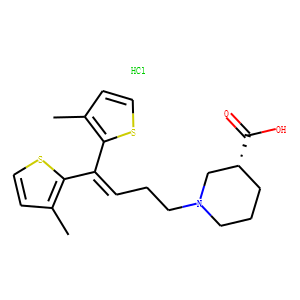| InChI | InChI=1S/C20H25NO2S2.ClH/c1-14-7-11-24-18(14)17(19-15(2)8-12-25-19)6-4-10-21-9-3-5-16(13-21)20(22)23;/h6-8,11-12,16H,3-5,9-10,13H2,1-2H3,(H,22,23);1H/t16-;/m1./s1 |
| Reference | 1:Brain Res. 1997 Apr 11;753(2):260-8. Tigabine hydrochloride, an inhibitor of gamma-aminobutyric acid (GABA) uptake, induces cortical depolarizations in vitro.Hu RQ,Davies JA, PMID: 9125411 <br />
<span>Abstract:</span> The effect of the gamma-aminobutyric acid uptake inhibitor tiagabine hydrochloride was studied on electrical responses in cortical wedges prepared from 20-30 day-old, audiogenic seizure-prone DBA/2 mice. Perfusion of tiagabine (50 microM) for 15 min, evoked large, slow depolarizations with a frequency of 6-8/h which persisted for 4-5 h. The GABA(A) receptor antagonists, bicuculline (10 microM) and picrotoxin (100 microM), inhibited established depolarizations. These depolarizations were also calcium-dependent and blocked by tetrodotoxin. The non-opioid antitussive, dextromethorphan, which has been shown to inhibit glutamate release, irreversibly blocked the depolarizations. Conversely, 4-aminopyridine (50 microM), a potassium channel antagonist, markedly potentiated the responses. The NMDA receptor antagonist, 3-((R)-2-carboxypiperazin-4-yl)-propyl-1-phosphonic acid, had no effect on the depolarizations at concentrations up to 100 microM but the AMPA/kainate receptor antagonist, 6,7-dinitroquinoxaline-2.3-dione at high concentrations (100 and 200 microM), reversibly decreased the frequency without affecting the amplitude. It is concluded that the tiagabine-induced depolarizations in this in vitro preparation were initiated through GABA(A) receptors leading, possibly, to a release of excitatory amino acids.
|

